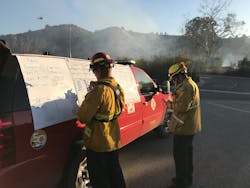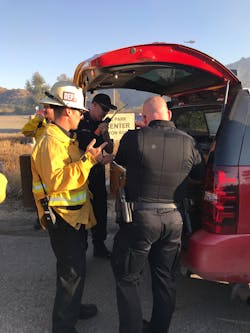The wildfire problem in the United States is real. The National Interagency Fire Center reported a total of 58,733 wildfires in 2021, which consumed 7,139,713 acres. Recent contributing factors include persistent and record-breaking drought conditions, beetle kill, natural and human-made causes, forest management practices and explosive home growth into the wildland-urban interface (WUI). When combined with high temperatures, low humidity and strong winds, the stage is set for firefighters to be stretched to their limits as they never have before. That said, the WUI environment can be successfully mitigated, in part, if early action is taken. One of the key ways to prepare for an incident is establishing and nurturing relationships with local, state, and federal partner agencies and regional stakeholders.
Partner agencies
The first step to consider when preplanning for a WUI fire is connecting with the partner agencies and stakeholders that incident commanders (ICs) need to unify or confer with to make tactical and strategic decisions.
Wind-driven fires are complex. They don’t adhere to jurisdictional boundaries, and they often require a multi-agency and multi-jurisdictional approach and response. Look at your jurisdiction’s geographic boundaries and identify agencies that are within/surround the fire department’s borders.
Examples of partner agencies and stakeholder groups might include, but certainly aren’t limited to:
- Other fire agencies (municipal, state and federal)
- Law enforcement agencies (local, county and state)
- Federal, state and county parks
- Utility companies (electric, gas, water)
- The American National Red Cross, Community Emergency Response Teams (CERT), animal control agencies
- Homebuilders associations
- Elected officials (local, county and state)
- Homeowners associations
Outside resources
The next step is to develop or update mutual aid or automatic aid agreements. Work to establish intergovernmental agreements (IGA) that outline the commitment of physical and human resources, any cost that might be incurred by the requesting agency and any limitations to how long the resources are available for use. For example, if a partner agency has rotary-wing or fixed-winged assets, which are incredibly expensive to operate, how long can an IC utilize those resources before there is an expectation to pay for them? (IGAs commonly allow the utilization of helicopters and aircraft for the first operational period.) Check with state and federal partners to identify resource availability and the process for ordering and utilizing equipment.
Other specialized resources that might be needed that require a conversation might include hand crews, bulldozers and water tenders.
In-kind resources, fire engines, trucks and ambulances often are available in most fire departments. These resources and vehicles easily can be reciprocated.
Work to develop response plans to the areas of greatest concern, deploying pre-identified resources from the region that are outlined in the agreements.
Historically, law enforcement and fire departments haven’t operated well together in the unified command environment, in large part, because fire departments routinely operate in the incident command system (ICS) while police departments don’t. However, since 9/11, all first responders have taken a more proactive approach to implementing and utilizing the ICS.
It’s critical to identify law enforcement jurisdictional responsibility as soon as possible and to establish a strong working relationship with those departments. For example, in Colorado, the county sheriff manages wildfire incidents.
Take time to meet with command staff and to outline and practice the roles and responsibilities that individuals play during a WUI fire. Municipal police departments, sheriff’s departments and the state highway patrol are essential in regard to the the notification, evacuation, security, traffic control and reunification of residents within the affected community(ies). Without doubt, the coordination and application of law enforcement functions are critical to the successful outcome of a WUI fire.
Federal, state and county parks and utility companies are key stakeholder groups that fire officials should meet. Protected wildlife, waterways, historical sites, pipelines, power stations and transmission lines all are critical infrastructure that must be defended.
In June 1988, several wildfires in Yellowstone National Park threatened the Old Faithful Inn, which is a historic landmark. Numerous resources were put into action to provide structure defense. As a result, the inn was saved.
Identifying critical assets before a fire and the resources that are required to protect those assets must be determined and incorporated into the pre-fire planning process. County parks and utility companies might have resources at your disposal. They will have a vested interest in protecting the physical and natural resources within their purview.
Outside personnel
In Southern California, a common mantra that’s echoed at preseason, interagency training is the idea of “How are you?” not “Who are you?”
During a wind-driven interface fire, time is of the essence. As the IC, you already are behind the power curve. If a fire is threatening or already consuming structures, valuable time is wasted trying to foster a relationship with strangers. Their strengths, weaknesses, areas of expertise, decision-making under stressful situations, etc., are all unknown variables that ICs don’t have time to evaluate at the time of an incident.
Wildfire preparation is best done by identifying partner agencies and stakeholders and establishing relationships that are based on mutual respect, collaboration and trust. Then, when individuals from agencies arrive at the incident command post, incident assignments can be made confidently, having an already established rapport. Team performance is significantly enhanced when opportunities to collaborate occur.
Red Cross, CERTs, animal control and churches can provide resources in the way of personnel and logistical support, including food, water and shelter. During the Cameron Peak Fire, the Larimer County Sheriff Office assisted homeowners with animal evacuation. Animals were transported to an events center, where they were cared for until they could be returned to their owners.
Private entities also exist to provide similar services. Network within the department’s service area to help to identify these groups and to discuss what their role would be before, during and after the incident. Long after the fire is out, homeowners will need substantial assistance to recover, not unlike other human-made or natural disasters.
Prepare, prepare, prepare
A wind-driven WUI fire can be one of the most complex, dangerous and dynamic incidents for fire departments and their members to handle. Unfortunately, wildland fires are occurring more frequently and with greater ferocity than they did over the past years and decades.
Some of the challenges to departments that operate in/adjacent to the WUI that materialize during devastating wildfires can be minimized, and that’s accomplished through purposeful action—relationship building, developing pre-fire plans, and implementing sound strategic and tactical-level decision-making.
As the founding father of the American fire service, Benjamin Franklin, is quoted as saying, “By failing to prepare, you are preparing to fail.” With the increase in the number of wildfires, political momentum and an engaged public, it’s incumbent on fire departments to capitalize on finding ways to prepare.
Residential Structures
Homebuilders, homeowners associations and elected officials are stakeholder groups to consider in the effort to create tactical and strategic decisions for the wildland-urban interface.
Homebuilders associations often carry significant political clout. (A great example of their lobbying power is residential sprinkler systems.) It isn’t out of the realm of possibility for a partnership to emerge between builders, elected officials and fire departments to find ways to build houses in the interface that are more likely to withstand the onslaught of a wildfire.
Residents who live in the interface or intermix are keen on the inherent dangers of living in fire-prone areas. As such, communities often are eager to participate in keeping their houses safe from wildfire.
A wildfire mitigation program that was established by Tri-Lakes Monument Fire Protection District, which was partially funded by the NFPA, partnered the fire district with a homeowners association to thin and remove brush. The district provides staff and a tow vehicle and chipper. In turn, the homeowners association identifies volunteers to help with the chipping effort.
Free home inspections that are conducted by the fire department are yet another way to engage the public in partnering to keep their houses more resilient to fire.
Elected officials are beginning to take more interest in the increasing prevalence of wildfires, particularly in the western United States. With a keen concern regarding funding and enforcing wildfire resiliency through legislation, fire departments have a unique opportunity to capitalize on political support.
About the Author

Andy Kovacs
Andy Kovacs is the fire chief of the Tri-Lakes Monument Fire Protection District in Colorado. Previously, he spent nearly 30 years with Orange County, CA, Fire Authority and witnessed firsthand the devastating effects of wildland-urban interface fires. Kovacs has been promoted through the ranks from firefighter to fire chief, including assignments as a fire academy instructor, a training captain, a training battalion chief, and an EMS supply and equipment coordinator.


